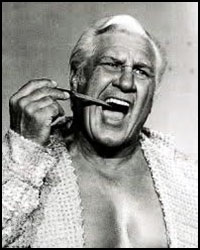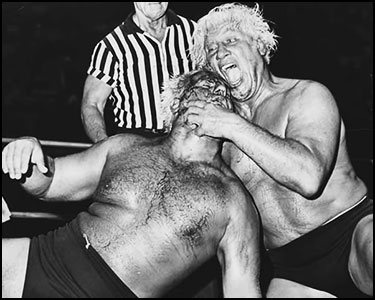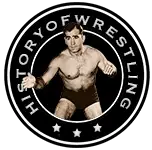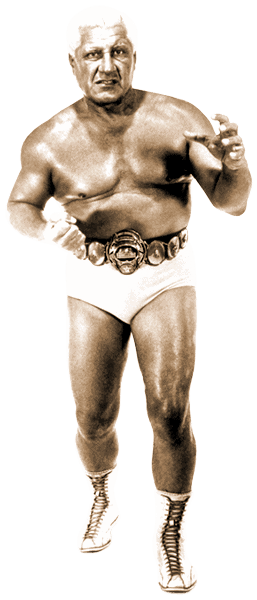by Stephen Von Slagle
Fred Blassie, the self-proclaimed “Fashion Plate of Wrestling,” was among the most decorated champions and recognizable performers in the business during a stellar career that spanned over 40 years.
Like many performers of his era, Blassie began his career while still a teenager and he spent years paying his dues while learning the trade. Eventually, though, he acquired the experience and skill (and, later, the right gimmick) needed to rise up the ranks. Although he is generally remembered for his many years as one of the WWF’s premier managers, the majority of his four decades in professional wrestling was actually spent inside the ring, as one of the most feared villains, prolific champions and top box-office attractions in the entire business.
His first major success came in the Peachtree State of Georgia, where he wrestled for over six years. “Classy” Freddie Blassie was, by far, the most hated villain in the territory during his lengthy stay in Georgia and he engaged in memorable feuds with Ray Gunkel, Dick Steinborn and other top babyfaces of the day. Furthermore, he utterly dominated the region’s most prestigious title, the NWA Southern Heavyweight championship, and enjoyed a record fourteen reigns as the Southern champion between 1954-1960.
 The World Wrestling Association was the next major stop for Blassie and his winning ways continued, to say the least. The self-proclaimed “King of Men” quickly established himself as the top performer in California and he would capture the WWA World Heavyweight title on four different occasions while engaging in main-event battles with memorable opponents such as John Tolos, Rikidozan, Édouard Carpentier, The Destroyer and Dick the Bruiser.
The World Wrestling Association was the next major stop for Blassie and his winning ways continued, to say the least. The self-proclaimed “King of Men” quickly established himself as the top performer in California and he would capture the WWA World Heavyweight title on four different occasions while engaging in main-event battles with memorable opponents such as John Tolos, Rikidozan, Édouard Carpentier, The Destroyer and Dick the Bruiser.
Due to his heated feud with Rikidozan, he also became a legendary villain in Japan, challenging the Japanese superstar for the WWA World title and garnering huge TV ratings in the process. Playing the role of the “Ugly American” was a specialty of Blassie’s and he shocked the Japanese public with his propensity to draw blood by using his teeth, which he famously “sharpened” with a nail file.
Back in the States, Blassie eventually travelled east to Vince McMahon Sr.’s World Wide Wrestling Federation and engaged in a storied feud with reigning WWWF kingpin Bruno Sammartino, a series of matches that did incredible business throughout the multi-state territory. Several years later, he returned to the east coast and, with Lou Albano as his manager, began an equally successful rivalry against WWWF champion Pedro Morales.
 However, by the mid-1970s, following nearly thirty years inside of the squared circle, a battle-worn “Classy” Freddie Blassie made the transition from wrestler to manager and immediately established himself as a heat-magnet for his wrestlers. While he was paired with flamboyant heels such as a young Hulk Hogan and Jesse Ventura, over time, Blassie seemed to specialize in guiding the careers of anti-American “foreigners” such as Spiros Arion, Masa Saito, Victor Rivera, Peter Maivia, Mr. Fuji, Killer Khan, Professor Toru Tanaka, Nicolai Volkoff and, of course, The Iron Sheik.
However, by the mid-1970s, following nearly thirty years inside of the squared circle, a battle-worn “Classy” Freddie Blassie made the transition from wrestler to manager and immediately established himself as a heat-magnet for his wrestlers. While he was paired with flamboyant heels such as a young Hulk Hogan and Jesse Ventura, over time, Blassie seemed to specialize in guiding the careers of anti-American “foreigners” such as Spiros Arion, Masa Saito, Victor Rivera, Peter Maivia, Mr. Fuji, Killer Khan, Professor Toru Tanaka, Nicolai Volkoff and, of course, The Iron Sheik.
Although he retired in 1986 and was inducted into the WWE Hall of Fame in 1994, Blassie remained a visible and entertaining part of WWE for years to come. His final appearance came on the May 12, 2003 edition of Monday Night Raw.
Fred Blassie was honored by the Cauliflower Alley Club in 1998 and received the PWI Stanley Weston Award in 2000. He is also a member of the WWF Hall of Fame (1994), the Wrestling Observer Newsletter Hall of Fame (1996), the Professional Wrestling Hall of Fame and Museum (2004), the NWA Hall of Fame (2011).
“Classy” Freddie Blassie died of kidney failure on June 2, 2003 at the age of 85.

